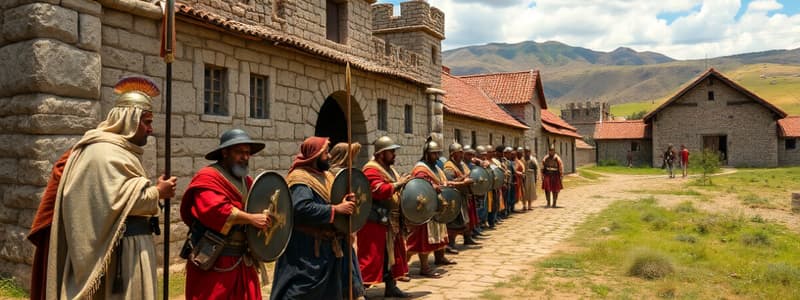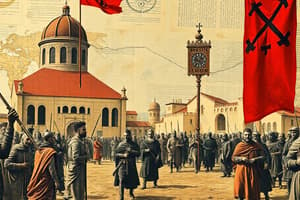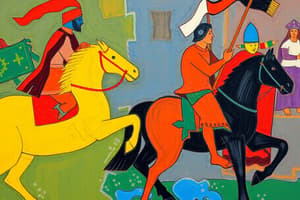Podcast
Questions and Answers
¿Qué evento marcó el inicio de la Edad Media?
¿Qué evento marcó el inicio de la Edad Media?
- La caída del Imperio Romano de Occidente en 452 d.C. (correct)
- El gran saqueo de Roma por los visigodos en 410 d.C.
- El establecimiento del Imperio Carolingo.
- La caída del Imperio Romano de Oriente en 353 d.C.
¿Cuál fue la causa principal de la Peste Negra en la Europa medieval?
¿Cuál fue la causa principal de la Peste Negra en la Europa medieval?
- Una epidemia causada por las pulgas de las ratas, que generaba erupciones. (correct)
- Una peste generada por los gatos y el mal saneamiento de las ciudades.
- Una enfermedad transmitida principalmente por el consumo de carne contaminada.
- Una epidemia causada por la mordedura de perros que generaba alteraciones neurológicas.
¿A qué figura histórica debe su nombre el Imperio Carolingio?
¿A qué figura histórica debe su nombre el Imperio Carolingio?
- Clodoveo, unificador de los francos.
- Pipino el Breve, emperador del imperio.
- Hugo, sucesor del imperio Carolingio.
- Carlo Magno, rey de los Francos. (correct)
¿Cuál fue el conflicto principal que dio origen a las Cruzadas?
¿Cuál fue el conflicto principal que dio origen a las Cruzadas?
¿Qué evento se considera un factor clave en el fin de la Edad Media?
¿Qué evento se considera un factor clave en el fin de la Edad Media?
¿Cuál es el orden cronológico correcto de los siguientes eventos relacionados con las Cruzadas?
¿Cuál es el orden cronológico correcto de los siguientes eventos relacionados con las Cruzadas?
En el contexto de las Cruzadas, ¿qué motivó el llamado del Papa Urbano II en el Concilio de Clermont?
En el contexto de las Cruzadas, ¿qué motivó el llamado del Papa Urbano II en el Concilio de Clermont?
¿Cuál de las siguientes opciones describe mejor uno de los objetivos principales de las Cruzadas?
¿Cuál de las siguientes opciones describe mejor uno de los objetivos principales de las Cruzadas?
¿Qué papel desempeñó el rey Isaac II Angelo en la Tercera Cruzada?
¿Qué papel desempeñó el rey Isaac II Angelo en la Tercera Cruzada?
¿Cuál de las siguientes afirmaciones describe mejor el resultado de la Primera Cruzada?
¿Cuál de las siguientes afirmaciones describe mejor el resultado de la Primera Cruzada?
Flashcards
Fall of Western Roman Empire
Fall of Western Roman Empire
The start of the Middle Ages is marked by this event in 452 AD.
The Black Death
The Black Death
An epidemic in Europe, caused by fleas on rats, leading to black eruptions.
Carolingian Empire
Carolingian Empire
Named after Charlemagne, King of the Franks.
The Crusades
The Crusades
Signup and view all the flashcards
Fall of Eastern Roman Empire
Fall of Eastern Roman Empire
Signup and view all the flashcards
Al-Andaluz
Al-Andaluz
Signup and view all the flashcards
The Crusades Start
The Crusades Start
Signup and view all the flashcards
Humanism
Humanism
Signup and view all the flashcards
Koran
Koran
Signup and view all the flashcards
Study Notes
- The study notes cover topics related to the Middle Ages, Ecuadorian cultures, the Crusades, civilizations of the Americas, Abrahamic religions, the Renaissance, and key concepts in social studies.
The Middle Ages
- The Middle Ages began in 452 AD with the fall of the Western Roman Empire.
- The "Black Death" or "Great Plague" was an epidemic caused by rat fleas, leading to nauseating eruptions that turned black.
- The Carolingian Empire is named after Carlo Magno (Charlemagne), King of the Franks.
- The Crusades were a result of conflicts between Muslims and Christians.
- The end of the Middle Ages was caused by the fall of the Eastern Roman Empire.
Ecuadorian Cultures
- Students are required to locate the cultures of Ecuador on a map.
The Crusades
- The Crusades involved a series of events, which must be chronologically ordered.
- The Muslim invasion advanced, creating a powerful empire with organizational challenges.
- The Carolingian Empire expanded among the Lombards, halting the Muslim advance into Europe.
- Muslims gained control of the Visigothic kingdom, later called Al-Andaluz.
- After Muhammad's death, emirs expanded their rule, controlling parts of Egypt, Israel, the Arabian Peninsula, and areas of Africa.
- The Crusades began with the goal of reconquering Jerusalem.
- During the Third Crusade, the Byzantine Empire fought against Western Christian kingdoms and Muslims due to Isaac II Angelo's alliance with Salad Ad-Din.
- Christians reconquered Jerusalem and maintained control, establishing the County of Edessa.
- The Council of Clermont was requested by Pope Urban II to aid Emperor Alexios I Komnenos in stopping the Muslim advance on Turkey.
Civilizations of the Americas
- The key characteristics of the Inca, Maya, and Aztec civilizations are compared and classified.
Abrahamic Religions
- The main aspects and criteria of Abrahamic religions (Islam, Judaism, Christianity) are analyzed.
Renaissance and Humanism
- The main causes of the emergence and expansion of Humanism and the Renaissance are discussed.
Renaissance Figures
- The images and information about important Renaissance figures should be matched with the correct name: Nicolas Maquiavelo, Tomás Moro, Erasmo de Rotterdam, Giovani Boccaccio, Dante Alighieri, Francisco Petrarca.
Contributions of Greek Civilization
- The statements corresponding to the contributions of the Greeks to later societies are identified.
Key Concepts
- Relationships between key concepts and their meanings:
- Islam: Sometimiento a Dios (Submission to God).
- Bible: Libros. Texto sagrado de la religión profesada por Jesús (Books. Sacred text of the religion professed by Jesus).
- Koran: Alabanza o adoración (Praise or adoration).
- Edict: Mandato o decreto ordenado por una figura de autoridad para la revisión u observación de un asunto en particular (Mandate or decree ordered by an authority figure for the review or observation of a particular matter).
- Caliphate: Forma de organización social basada en la figura de un sucesor del profeta Mahoma (Form of social organization based on the figure of a successor to the prophet Muhammad).
- Crusades: Guerras de carácter religioso que buscaban en su tiempo la recuperación de territorios santos y la expansión de las religiones involucradas por todo el mundo antiguo (Religious wars that sought in their time the recovery of holy territories and the expansion of the religions involved throughout the ancient world).
- Empire: Estado en el que los poderes y funciones estatales se consolidan en una sola persona: el rey (State in which the powers and state functions are consolidated in one person: the king).
- Humanism: Corriente filosófica y artística que sitúa al hombre como el centro del universo y del conocimiento (Philosophical and artistic movement that places man as the center of the universe and knowledge).
- Kingdom: Un imperio es una unidad política estatal que ejerce control sobre una amplia extensión de terreno (An empire is a state political unit that exercises control over a large extension of land).
Studying That Suits You
Use AI to generate personalized quizzes and flashcards to suit your learning preferences.





